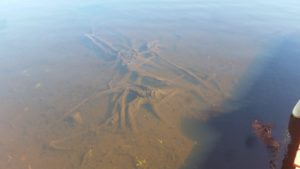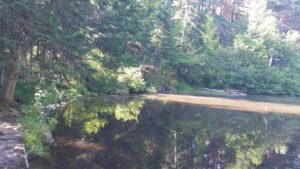We watched the lunar eclipse the other night, going out every half hour or so for quick peeks — it was cold out! — until just a little after midnight. We used binoculars to get more detail, and we had a perfect view. We caught the very first appearance of the shadow, watched the gradually growing coverage until it was complete and the Moon was a dark red ball, and finally saw the shadow begin its retreat before we called it a night. (We saw photos later where the occluded Moon looked blue, but for us it was red, a deep and rusty, almost brownish red.) The show was awesome in all senses of the word, and “Superwolf Bloodmoon” sounds like a great name for a band — maybe names for two bands…
Updating The Databases
I’ve been updating my Sals trail map in QGIS, and I think I now have most of the new trail name/blaze changes, definitely all the changes I could verify on the ground, documented. I’m working on actually making a big paper map from all my data, which requires that I now learn some actual cartography skills. I put that project away to let it simmer for a while, and went back to my list of trail amenities.
In terms of actual, usable data, that list is a hot mess: restaurants and bars have closed or changed names, new establishments have opened, many long-established places were still missing from the list (because they were never on OpenStreetMap, my primary source), and, worst of all, most of the amenities had no other information than name and location. I spent a good part of the last few days adding and removing establishments, and finding phone numbers and other contact info, and generally updating the list. I still have a ways to go, but Bethlehem is starting to look complete.
The final database update was for my family tree, which I maintain in GRAMPS genealogy software. (The problem was that I might have “intercalated” an imaginary person into the tree: there is a Dorothy Murphy in my database, a distant cousin who might have had a niece Dorothy Mahoney, and either Dorothy Mahoney married Tom Hagenberg, or Dorothy Mahoney never existed and it was Dorothy Murphy who married Tom Hagenberg. My database had the “Dorothy Mahoney is real” version.)
This issue came up a few years ago in conversation with my parents, but I never got around to fixing it in GRAMPS, and eventually forgot which version was correct. I happened to be looking at old photos the other day though, and there was Dorothy Hagenberg, handing out cake at a child’s birthday party in the late 1940’s, and the whole thing was back in my face… A little email correspondence this week with Mom got the family tree straightened out, and fixing it in GRAMPS was surprisingly easy — Dorothy Mahoney is no more. There’s a lot of missing information in this database as well, but at least that one known error has been corrected.
Cello Time
My cello playing has been coming along, not in leaps and bounds but I am progressing… I’ve got a few songs under my belt now, and I am working on possible duets with Anne, and my lessons are starting to get beyond the very basics — I’m now working on the regular basics…



